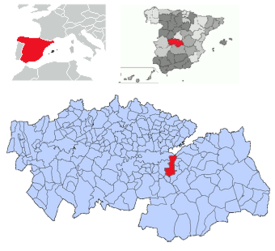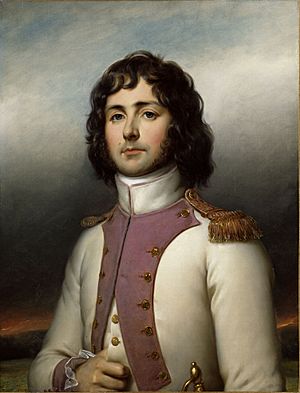Battle of Almonacid facts for kids
Quick facts for kids Battle of Almonacid |
|||||||
|---|---|---|---|---|---|---|---|
| Part of the Peninsular War | |||||||
 |
|||||||
|
|||||||
| Belligerents | |||||||
| Commanders and leaders | |||||||
| Strength | |||||||
| 21,000 | 23,000 | ||||||
| Casualties and losses | |||||||
| 2,400 | 3,300-3,500 killed & wounded 2,000 captured 20-21 guns lost Total: 5,500 |
||||||
The Battle of Almonacid was a big fight during the Peninsular War on August 11, 1809. It happened between the French army, led by General Sébastiani, and the Spanish army, led by General Francisco Javier Venegas. The French army had been protecting Madrid and was ordered to attack the Spanish forces. After some strong attacks, especially by Polish cavalry, the French won the battle.
Contents
What Led to the Battle?
The Peninsular War was a long conflict in Spain and Portugal. In 1809, battles were happening all over Spain. The Battle of Almonacid followed another important fight called the Battle of Talavera.
Getting Ready for the Fight
After losing at Talavera, King Joseph of Spain (who was Napoleon's brother and ruling for France) moved his French army near Toledo. He told General Sébastiani to attack the Spanish army. This Spanish army, led by General Venegas, was threatening Madrid.
On August 5, Sébastiani tried to attack the Spanish at Aranjuez. But his attack was too quick, and the French lost that small battle. Sébastiani then decided to try a different plan. He moved his army west, crossed the Tagus River at Toledo, and planned to attack the Spanish from the east.
However, General Venegas guessed what Sébastiani would do. He moved his Spanish forces west, staying south of the Tagus River. By August 10, both armies were close to each other, near a town called Almonacid.
The Armies Gather
The Spanish army, led by Venegas, had about 22,000 foot soldiers, over 3,000 horsemen, and 29 cannons. They were very confident they would win. They didn't even set up their camp safely, even though the enemy was so close.
General Sébastiani's French army had crossed the Tagus River on August 9. They set up camp in a nearby town called Nambroca, which was only a short distance from Almonacid.
The Spanish generals decided to attack the French on August 12. They wanted their troops to rest first. But the French army didn't wait. At 5:30 in the morning on August 11, the French appeared in front of the Spanish positions. Sébastiani attacked right away with 14,000 soldiers. He didn't even wait for more French troops, including King Joseph himself, to arrive.
The Spanish army quickly got into position around Almonacid. They spread out with different groups of soldiers on their right, center, and left sides. Their strongest point was on the far left, on the Cerrojones hills.
The Battle Unfolds
First Attacks Begin
The battle started with a lot of cannon fire from both sides. Then, French and Polish soldiers, led by Jean François Leval, attacked the Spanish army's left side. Spanish soldiers from the Bailén and Jaén battalions fought bravely and pushed back the Polish troops twice. But they didn't get help from their own reserve forces.
As more German soldiers joined the Polish attack, the French managed to capture the important Cerrojones hills. This was a tough fight, and the Polish soldiers lost many officers. The French also attacked on their right side, trying to surround the Spanish. Spanish horsemen tried to stop them, but they couldn't.
The Spanish forces on their left had to move back. Soon, the Spanish center and right sides also started to retreat. More French troops, including King Joseph, had arrived and were joining the attack. The Spanish troops were forced to gather on Castillo hill.
The Fight Continues
The Spanish soldiers on Castillo hill faced a terrible rain of cannonballs from the French. They couldn't hold their ground. Soon, the French took over the town and Castillo hill.
However, a Spanish division led by Gaspar de Vigodet arrived just in time. They quickly changed their position and fired their cannons. This helped stop the French from chasing the retreating Spanish soldiers. It also helped bring order back to the Spanish left side, where Polish and German soldiers were trying to surround them.
In this part of the battle, Vigodet's soldiers fought very bravely. The Spanish artillery kept firing as they moved back, covering their comrades. The Spanish cavalry gathered scattered troops and impressed the French with their steady fighting. Even a small group of Spanish grenadiers managed to stop French horsemen and capture a cannon.
But then, an accident happened. Some Spanish ammunition carts exploded, scaring the horses. This caused confusion, and the French took advantage of it. They chased the Spanish more closely, capturing some soldiers and cannons.
The Battle Ends
The French army had lost about 2,500 soldiers. They stopped chasing the Spanish after reaching the town of Mora. The Spanish army, though defeated, managed to retreat in good order towards Andalusia.
However, when they reached Manzanares, false rumors spread that French forces were in Valdepeñas. This caused many Spanish soldiers to scatter and run, not stopping until they reached the Sierra Morena mountains.
The Spanish lost about 4,000 men in total. This included soldiers who were killed, wounded, or captured. Among the dead was Colonel Vicente Martínez. Colonel Diego Ballesteros was wounded and became a prisoner of war in France until the war ended.
What Happened Next?
After the Battle of Almonacid, the Peninsular War continued. The next major event in the Spanish campaign of 1809 was the second attack on Madrid, which led to the Battle of Tamames.
Remembering the Battle
To honor the bravery shown in this battle, a special military medal was created on May 30, 1816. It had the words "From Fernando VII" in the middle and "In Almonacid, 11th August 1809" around the edge.
See also
 In Spanish: Batalla de Almonacid para niños
In Spanish: Batalla de Almonacid para niños


